Cultural Intelligence: Trompenaar's Onion Model and its Application
VerifiedAdded on 2023/06/05
|6
|1678
|462
AI Summary
This article discusses Trompenaar's Onion Model and its application to different cultures. It also explains the concept of cultural intelligence and how it can make you indispensable at work. The article includes a reflection on how to develop cultural intelligence and a list of corporate values of Wesfarmers.
Contribute Materials
Your contribution can guide someone’s learning journey. Share your
documents today.

Cultural intelligence
Name
Professor
Course
Date
Name
Professor
Course
Date
Secure Best Marks with AI Grader
Need help grading? Try our AI Grader for instant feedback on your assignments.
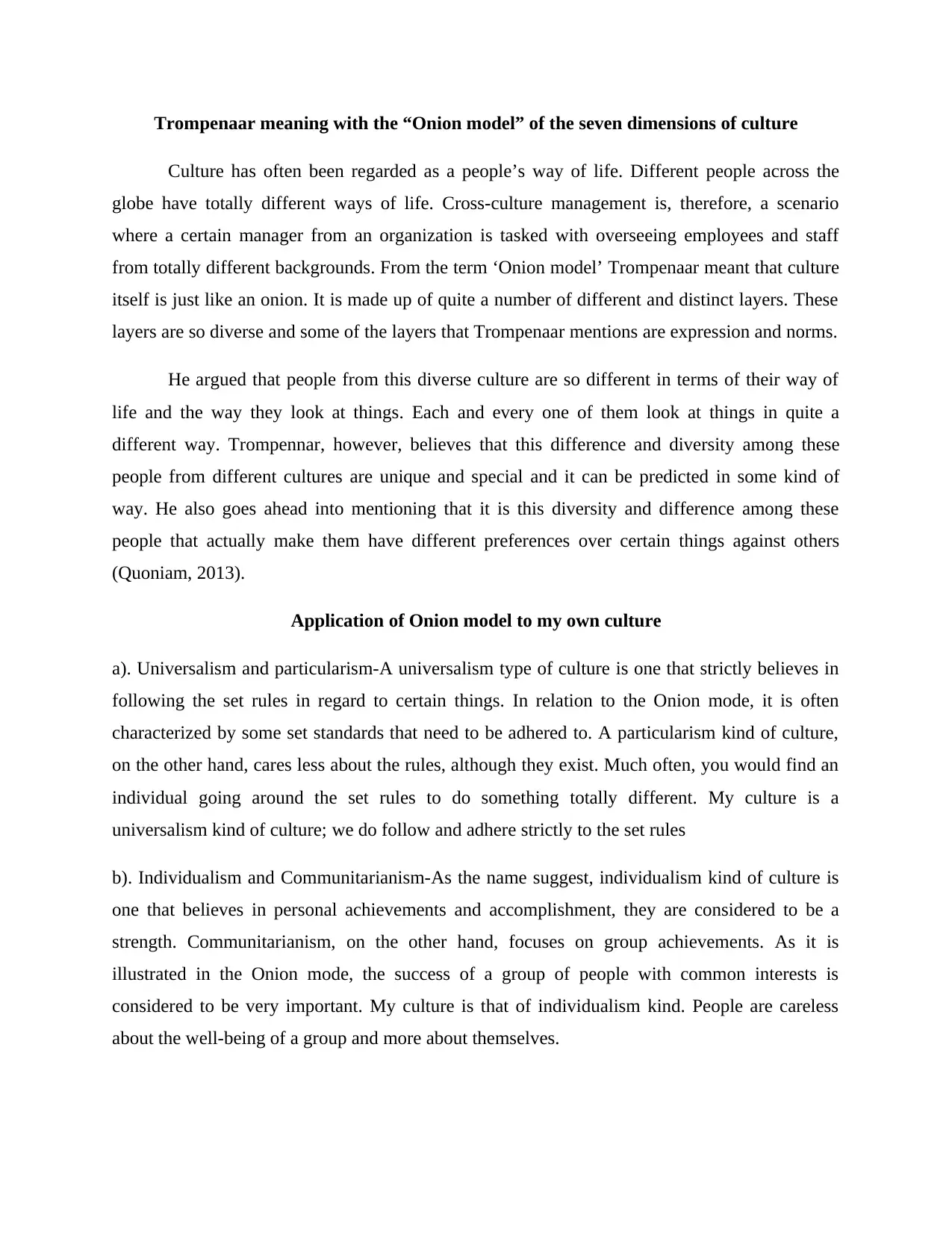
Trompenaar meaning with the “Onion model” of the seven dimensions of culture
Culture has often been regarded as a people’s way of life. Different people across the
globe have totally different ways of life. Cross-culture management is, therefore, a scenario
where a certain manager from an organization is tasked with overseeing employees and staff
from totally different backgrounds. From the term ‘Onion model’ Trompenaar meant that culture
itself is just like an onion. It is made up of quite a number of different and distinct layers. These
layers are so diverse and some of the layers that Trompenaar mentions are expression and norms.
He argued that people from this diverse culture are so different in terms of their way of
life and the way they look at things. Each and every one of them look at things in quite a
different way. Trompennar, however, believes that this difference and diversity among these
people from different cultures are unique and special and it can be predicted in some kind of
way. He also goes ahead into mentioning that it is this diversity and difference among these
people that actually make them have different preferences over certain things against others
(Quoniam, 2013).
Application of Onion model to my own culture
a). Universalism and particularism-A universalism type of culture is one that strictly believes in
following the set rules in regard to certain things. In relation to the Onion mode, it is often
characterized by some set standards that need to be adhered to. A particularism kind of culture,
on the other hand, cares less about the rules, although they exist. Much often, you would find an
individual going around the set rules to do something totally different. My culture is a
universalism kind of culture; we do follow and adhere strictly to the set rules
b). Individualism and Communitarianism-As the name suggest, individualism kind of culture is
one that believes in personal achievements and accomplishment, they are considered to be a
strength. Communitarianism, on the other hand, focuses on group achievements. As it is
illustrated in the Onion mode, the success of a group of people with common interests is
considered to be very important. My culture is that of individualism kind. People are careless
about the well-being of a group and more about themselves.
Culture has often been regarded as a people’s way of life. Different people across the
globe have totally different ways of life. Cross-culture management is, therefore, a scenario
where a certain manager from an organization is tasked with overseeing employees and staff
from totally different backgrounds. From the term ‘Onion model’ Trompenaar meant that culture
itself is just like an onion. It is made up of quite a number of different and distinct layers. These
layers are so diverse and some of the layers that Trompenaar mentions are expression and norms.
He argued that people from this diverse culture are so different in terms of their way of
life and the way they look at things. Each and every one of them look at things in quite a
different way. Trompennar, however, believes that this difference and diversity among these
people from different cultures are unique and special and it can be predicted in some kind of
way. He also goes ahead into mentioning that it is this diversity and difference among these
people that actually make them have different preferences over certain things against others
(Quoniam, 2013).
Application of Onion model to my own culture
a). Universalism and particularism-A universalism type of culture is one that strictly believes in
following the set rules in regard to certain things. In relation to the Onion mode, it is often
characterized by some set standards that need to be adhered to. A particularism kind of culture,
on the other hand, cares less about the rules, although they exist. Much often, you would find an
individual going around the set rules to do something totally different. My culture is a
universalism kind of culture; we do follow and adhere strictly to the set rules
b). Individualism and Communitarianism-As the name suggest, individualism kind of culture is
one that believes in personal achievements and accomplishment, they are considered to be a
strength. Communitarianism, on the other hand, focuses on group achievements. As it is
illustrated in the Onion mode, the success of a group of people with common interests is
considered to be very important. My culture is that of individualism kind. People are careless
about the well-being of a group and more about themselves.
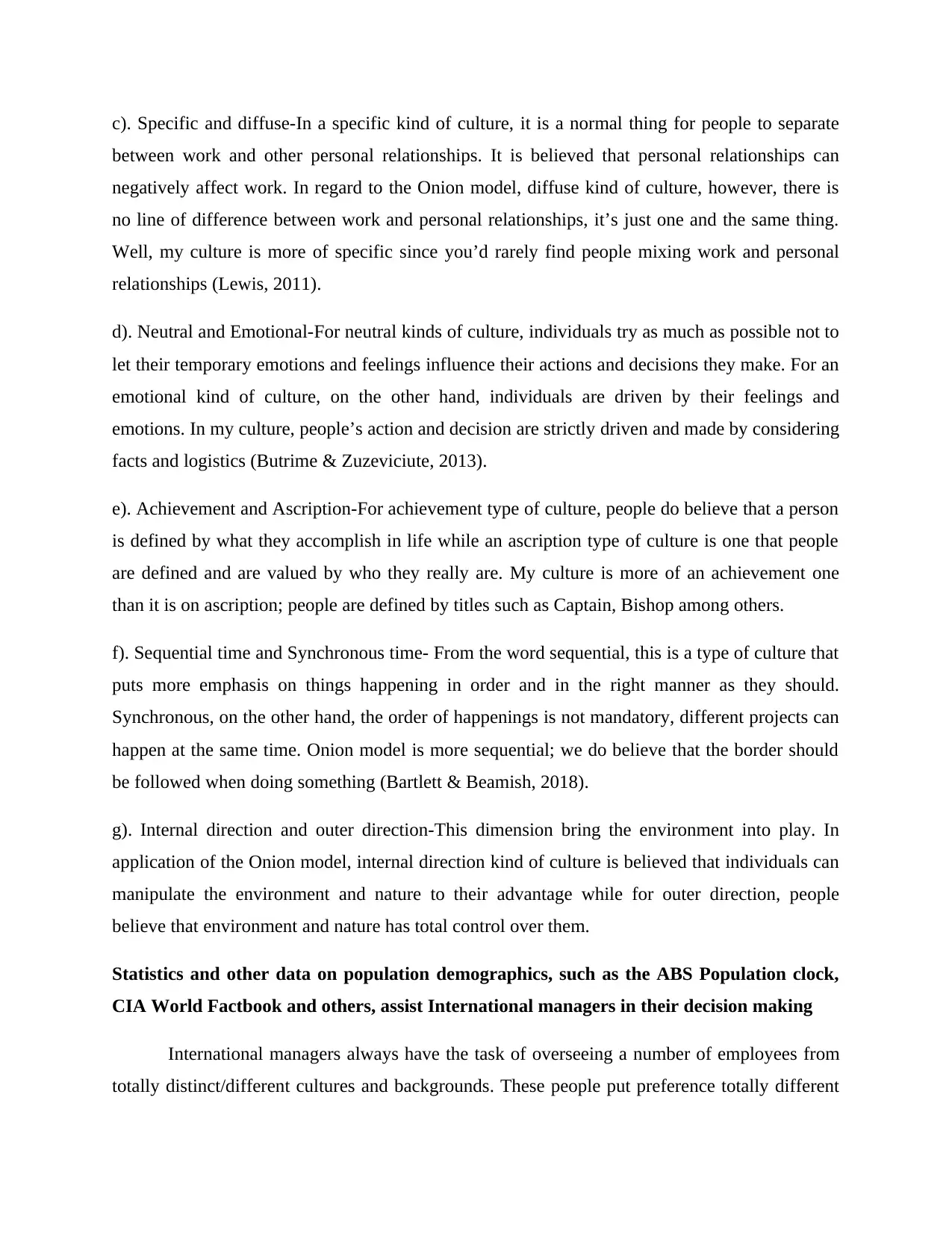
c). Specific and diffuse-In a specific kind of culture, it is a normal thing for people to separate
between work and other personal relationships. It is believed that personal relationships can
negatively affect work. In regard to the Onion model, diffuse kind of culture, however, there is
no line of difference between work and personal relationships, it’s just one and the same thing.
Well, my culture is more of specific since you’d rarely find people mixing work and personal
relationships (Lewis, 2011).
d). Neutral and Emotional-For neutral kinds of culture, individuals try as much as possible not to
let their temporary emotions and feelings influence their actions and decisions they make. For an
emotional kind of culture, on the other hand, individuals are driven by their feelings and
emotions. In my culture, people’s action and decision are strictly driven and made by considering
facts and logistics (Butrime & Zuzeviciute, 2013).
e). Achievement and Ascription-For achievement type of culture, people do believe that a person
is defined by what they accomplish in life while an ascription type of culture is one that people
are defined and are valued by who they really are. My culture is more of an achievement one
than it is on ascription; people are defined by titles such as Captain, Bishop among others.
f). Sequential time and Synchronous time- From the word sequential, this is a type of culture that
puts more emphasis on things happening in order and in the right manner as they should.
Synchronous, on the other hand, the order of happenings is not mandatory, different projects can
happen at the same time. Onion model is more sequential; we do believe that the border should
be followed when doing something (Bartlett & Beamish, 2018).
g). Internal direction and outer direction-This dimension bring the environment into play. In
application of the Onion model, internal direction kind of culture is believed that individuals can
manipulate the environment and nature to their advantage while for outer direction, people
believe that environment and nature has total control over them.
Statistics and other data on population demographics, such as the ABS Population clock,
CIA World Factbook and others, assist International managers in their decision making
International managers always have the task of overseeing a number of employees from
totally distinct/different cultures and backgrounds. These people put preference totally different
between work and other personal relationships. It is believed that personal relationships can
negatively affect work. In regard to the Onion model, diffuse kind of culture, however, there is
no line of difference between work and personal relationships, it’s just one and the same thing.
Well, my culture is more of specific since you’d rarely find people mixing work and personal
relationships (Lewis, 2011).
d). Neutral and Emotional-For neutral kinds of culture, individuals try as much as possible not to
let their temporary emotions and feelings influence their actions and decisions they make. For an
emotional kind of culture, on the other hand, individuals are driven by their feelings and
emotions. In my culture, people’s action and decision are strictly driven and made by considering
facts and logistics (Butrime & Zuzeviciute, 2013).
e). Achievement and Ascription-For achievement type of culture, people do believe that a person
is defined by what they accomplish in life while an ascription type of culture is one that people
are defined and are valued by who they really are. My culture is more of an achievement one
than it is on ascription; people are defined by titles such as Captain, Bishop among others.
f). Sequential time and Synchronous time- From the word sequential, this is a type of culture that
puts more emphasis on things happening in order and in the right manner as they should.
Synchronous, on the other hand, the order of happenings is not mandatory, different projects can
happen at the same time. Onion model is more sequential; we do believe that the border should
be followed when doing something (Bartlett & Beamish, 2018).
g). Internal direction and outer direction-This dimension bring the environment into play. In
application of the Onion model, internal direction kind of culture is believed that individuals can
manipulate the environment and nature to their advantage while for outer direction, people
believe that environment and nature has total control over them.
Statistics and other data on population demographics, such as the ABS Population clock,
CIA World Factbook and others, assist International managers in their decision making
International managers always have the task of overseeing a number of employees from
totally distinct/different cultures and backgrounds. These people put preference totally different
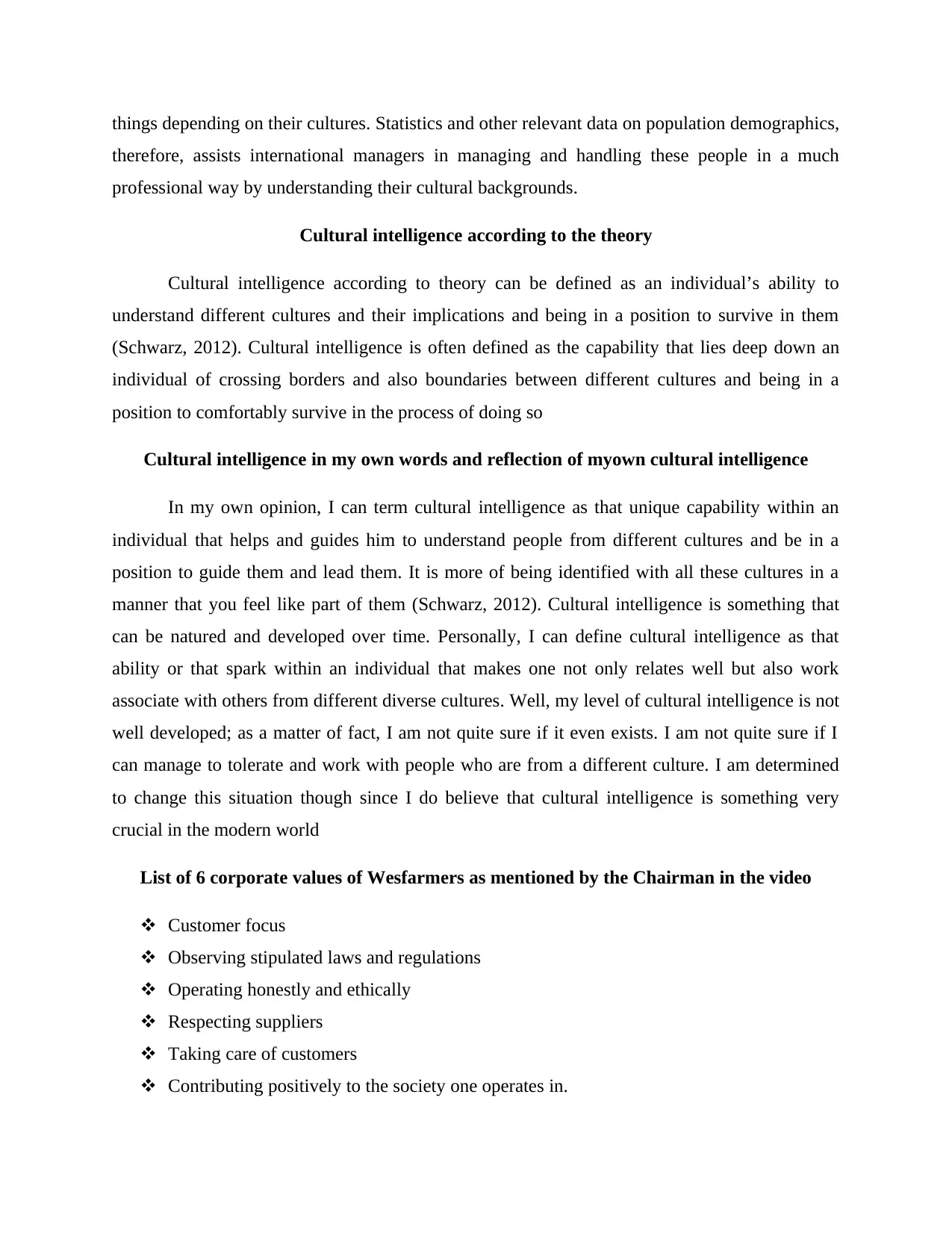
things depending on their cultures. Statistics and other relevant data on population demographics,
therefore, assists international managers in managing and handling these people in a much
professional way by understanding their cultural backgrounds.
Cultural intelligence according to the theory
Cultural intelligence according to theory can be defined as an individual’s ability to
understand different cultures and their implications and being in a position to survive in them
(Schwarz, 2012). Cultural intelligence is often defined as the capability that lies deep down an
individual of crossing borders and also boundaries between different cultures and being in a
position to comfortably survive in the process of doing so
Cultural intelligence in my own words and reflection of myown cultural intelligence
In my own opinion, I can term cultural intelligence as that unique capability within an
individual that helps and guides him to understand people from different cultures and be in a
position to guide them and lead them. It is more of being identified with all these cultures in a
manner that you feel like part of them (Schwarz, 2012). Cultural intelligence is something that
can be natured and developed over time. Personally, I can define cultural intelligence as that
ability or that spark within an individual that makes one not only relates well but also work
associate with others from different diverse cultures. Well, my level of cultural intelligence is not
well developed; as a matter of fact, I am not quite sure if it even exists. I am not quite sure if I
can manage to tolerate and work with people who are from a different culture. I am determined
to change this situation though since I do believe that cultural intelligence is something very
crucial in the modern world
List of 6 corporate values of Wesfarmers as mentioned by the Chairman in the video
Customer focus
Observing stipulated laws and regulations
Operating honestly and ethically
Respecting suppliers
Taking care of customers
Contributing positively to the society one operates in.
therefore, assists international managers in managing and handling these people in a much
professional way by understanding their cultural backgrounds.
Cultural intelligence according to the theory
Cultural intelligence according to theory can be defined as an individual’s ability to
understand different cultures and their implications and being in a position to survive in them
(Schwarz, 2012). Cultural intelligence is often defined as the capability that lies deep down an
individual of crossing borders and also boundaries between different cultures and being in a
position to comfortably survive in the process of doing so
Cultural intelligence in my own words and reflection of myown cultural intelligence
In my own opinion, I can term cultural intelligence as that unique capability within an
individual that helps and guides him to understand people from different cultures and be in a
position to guide them and lead them. It is more of being identified with all these cultures in a
manner that you feel like part of them (Schwarz, 2012). Cultural intelligence is something that
can be natured and developed over time. Personally, I can define cultural intelligence as that
ability or that spark within an individual that makes one not only relates well but also work
associate with others from different diverse cultures. Well, my level of cultural intelligence is not
well developed; as a matter of fact, I am not quite sure if it even exists. I am not quite sure if I
can manage to tolerate and work with people who are from a different culture. I am determined
to change this situation though since I do believe that cultural intelligence is something very
crucial in the modern world
List of 6 corporate values of Wesfarmers as mentioned by the Chairman in the video
Customer focus
Observing stipulated laws and regulations
Operating honestly and ethically
Respecting suppliers
Taking care of customers
Contributing positively to the society one operates in.
Secure Best Marks with AI Grader
Need help grading? Try our AI Grader for instant feedback on your assignments.
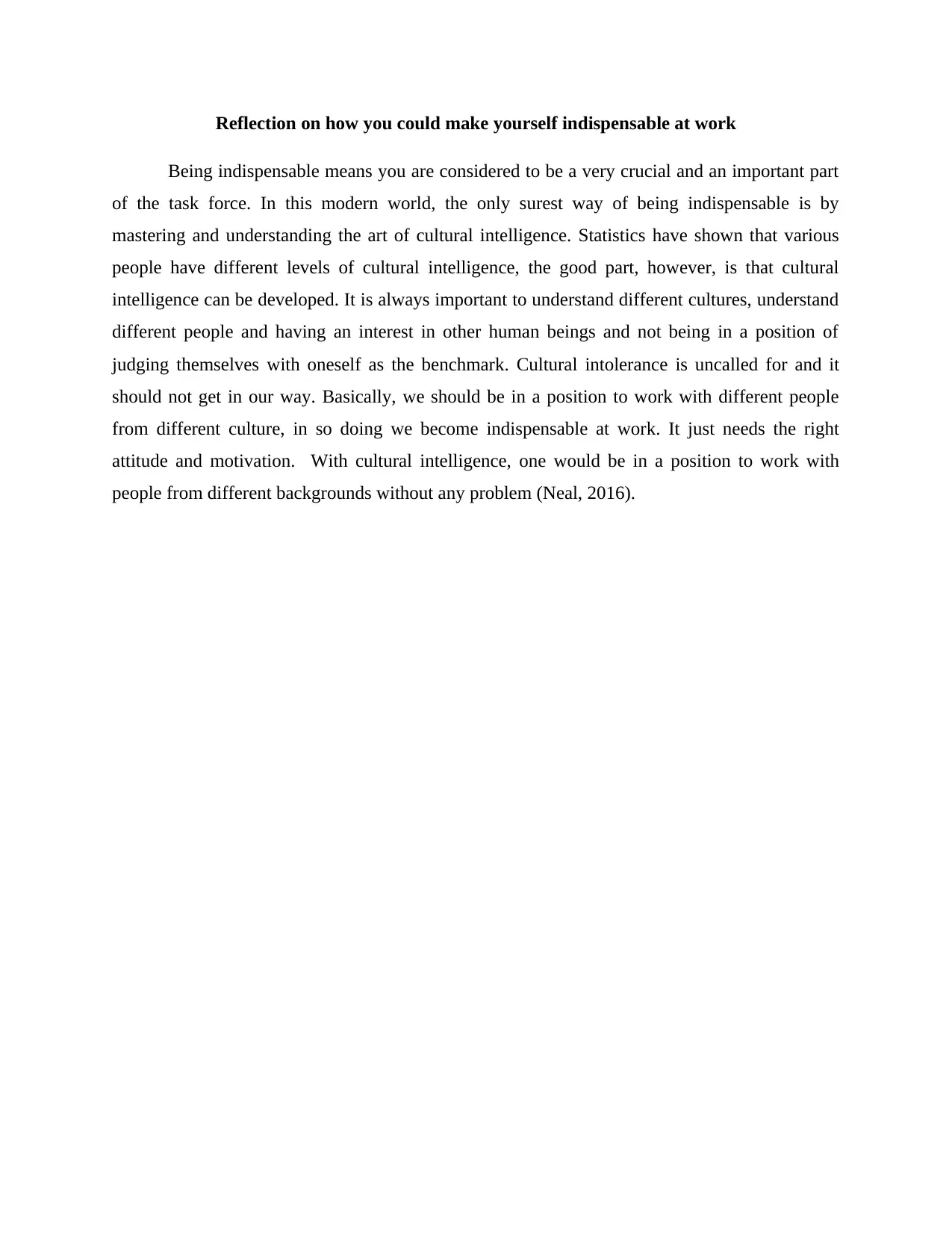
Reflection on how you could make yourself indispensable at work
Being indispensable means you are considered to be a very crucial and an important part
of the task force. In this modern world, the only surest way of being indispensable is by
mastering and understanding the art of cultural intelligence. Statistics have shown that various
people have different levels of cultural intelligence, the good part, however, is that cultural
intelligence can be developed. It is always important to understand different cultures, understand
different people and having an interest in other human beings and not being in a position of
judging themselves with oneself as the benchmark. Cultural intolerance is uncalled for and it
should not get in our way. Basically, we should be in a position to work with different people
from different culture, in so doing we become indispensable at work. It just needs the right
attitude and motivation. With cultural intelligence, one would be in a position to work with
people from different backgrounds without any problem (Neal, 2016).
Being indispensable means you are considered to be a very crucial and an important part
of the task force. In this modern world, the only surest way of being indispensable is by
mastering and understanding the art of cultural intelligence. Statistics have shown that various
people have different levels of cultural intelligence, the good part, however, is that cultural
intelligence can be developed. It is always important to understand different cultures, understand
different people and having an interest in other human beings and not being in a position of
judging themselves with oneself as the benchmark. Cultural intolerance is uncalled for and it
should not get in our way. Basically, we should be in a position to work with different people
from different culture, in so doing we become indispensable at work. It just needs the right
attitude and motivation. With cultural intelligence, one would be in a position to work with
people from different backgrounds without any problem (Neal, 2016).
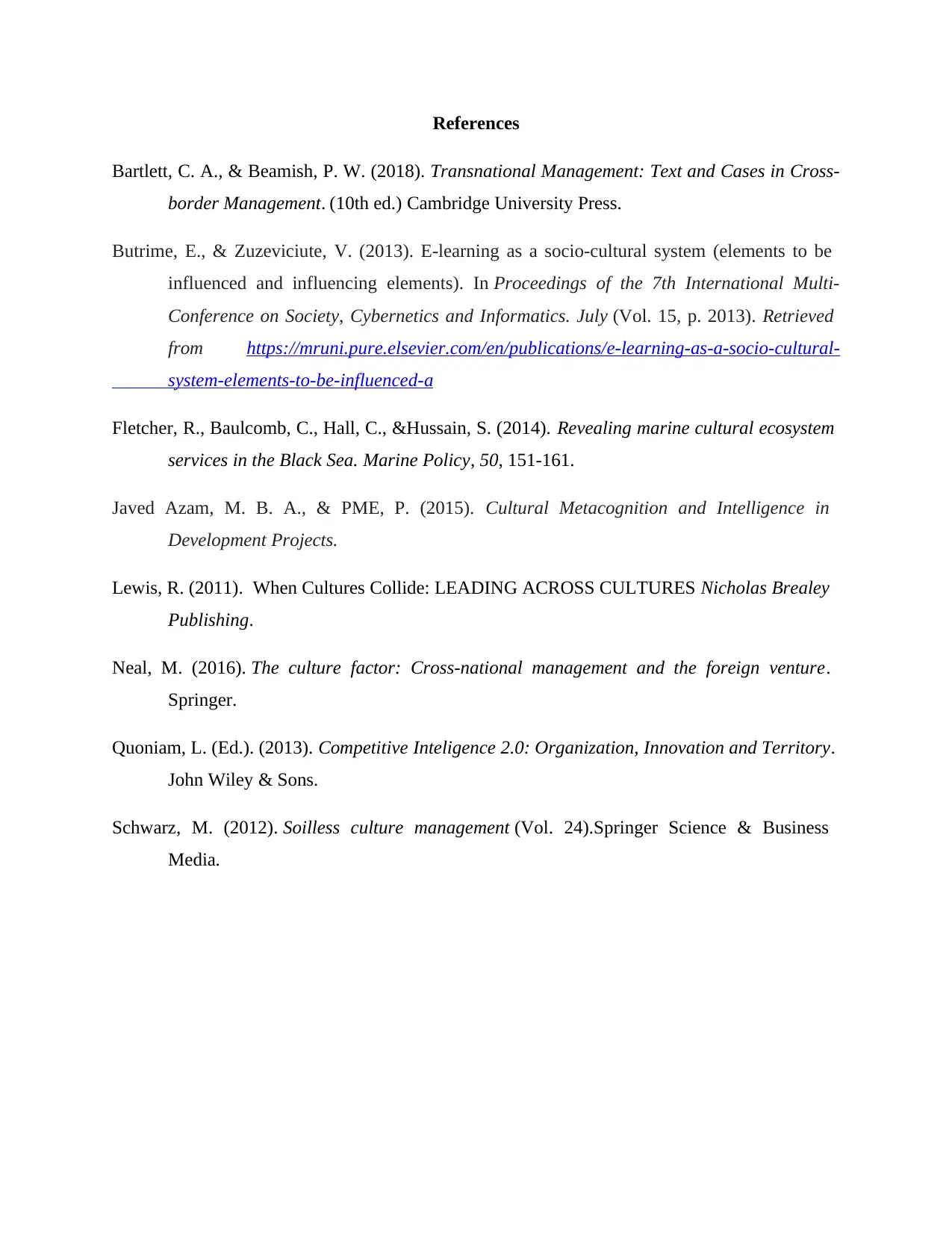
References
Bartlett, C. A., & Beamish, P. W. (2018). Transnational Management: Text and Cases in Cross-
border Management. (10th ed.) Cambridge University Press.
Butrime, E., & Zuzeviciute, V. (2013). E-learning as a socio-cultural system (elements to be
influenced and influencing elements). In Proceedings of the 7th International Multi-
Conference on Society, Cybernetics and Informatics. July (Vol. 15, p. 2013). Retrieved
from https://mruni.pure.elsevier.com/en/publications/e-learning-as-a-socio-cultural-
system-elements-to-be-influenced-a
Fletcher, R., Baulcomb, C., Hall, C., &Hussain, S. (2014). Revealing marine cultural ecosystem
services in the Black Sea. Marine Policy, 50, 151-161.
Javed Azam, M. B. A., & PME, P. (2015). Cultural Metacognition and Intelligence in
Development Projects.
Lewis, R. (2011). When Cultures Collide: LEADING ACROSS CULTURES Nicholas Brealey
Publishing.
Neal, M. (2016). The culture factor: Cross-national management and the foreign venture.
Springer.
Quoniam, L. (Ed.). (2013). Competitive Inteligence 2.0: Organization, Innovation and Territory.
John Wiley & Sons.
Schwarz, M. (2012). Soilless culture management (Vol. 24).Springer Science & Business
Media.
Bartlett, C. A., & Beamish, P. W. (2018). Transnational Management: Text and Cases in Cross-
border Management. (10th ed.) Cambridge University Press.
Butrime, E., & Zuzeviciute, V. (2013). E-learning as a socio-cultural system (elements to be
influenced and influencing elements). In Proceedings of the 7th International Multi-
Conference on Society, Cybernetics and Informatics. July (Vol. 15, p. 2013). Retrieved
from https://mruni.pure.elsevier.com/en/publications/e-learning-as-a-socio-cultural-
system-elements-to-be-influenced-a
Fletcher, R., Baulcomb, C., Hall, C., &Hussain, S. (2014). Revealing marine cultural ecosystem
services in the Black Sea. Marine Policy, 50, 151-161.
Javed Azam, M. B. A., & PME, P. (2015). Cultural Metacognition and Intelligence in
Development Projects.
Lewis, R. (2011). When Cultures Collide: LEADING ACROSS CULTURES Nicholas Brealey
Publishing.
Neal, M. (2016). The culture factor: Cross-national management and the foreign venture.
Springer.
Quoniam, L. (Ed.). (2013). Competitive Inteligence 2.0: Organization, Innovation and Territory.
John Wiley & Sons.
Schwarz, M. (2012). Soilless culture management (Vol. 24).Springer Science & Business
Media.
1 out of 6
Related Documents
Your All-in-One AI-Powered Toolkit for Academic Success.
+13062052269
info@desklib.com
Available 24*7 on WhatsApp / Email
![[object Object]](/_next/static/media/star-bottom.7253800d.svg)
Unlock your academic potential
© 2024 | Zucol Services PVT LTD | All rights reserved.



